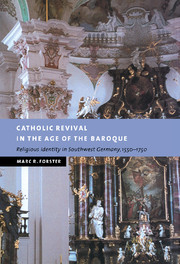Book contents
- Frontmatter
- Contents
- List of maps
- Acknowledgments
- List of abbreviations
- Introduction
- 1 The Counter-Reformation offensive, 1550–1650
- 2 The sacral landscape and pilgrimage piety
- 3 Religious practice
- 4 Clericalism in the villages
- 5 The communal church in German Catholicism
- 6 Reformers and intermediaries, 1650–1750
- Conclusion
- Bibliography
- Index
Conclusion
Published online by Cambridge University Press: 17 July 2009
- Frontmatter
- Contents
- List of maps
- Acknowledgments
- List of abbreviations
- Introduction
- 1 The Counter-Reformation offensive, 1550–1650
- 2 The sacral landscape and pilgrimage piety
- 3 Religious practice
- 4 Clericalism in the villages
- 5 The communal church in German Catholicism
- 6 Reformers and intermediaries, 1650–1750
- Conclusion
- Bibliography
- Index
Summary
The creation of Catholic identity in Southwest Germany was closely intertwined with the development and nature of Baroque Catholicism. Since the 1970s, historians have had much to say about “confessionalization,” emphasizing the role of the state and church institutions in imposing religious conformity. Other studies, like this one, point to the appeal of Catholic practices and argue that the wider population played a central role in developing their own identity as Catholics. All historians point to the vitality and popularity of Baroque Catholicism and the churchliness of the people as evidence of the strength of popular Catholic confessionalism.
A clearer understanding of what Baroque Catholicism was and how it developed should improve our understanding of long-term developments in German Catholicism. The chronology of popular Catholicism in Germany indicates several periods of religious revival, beginning with the intensification of religious life in the fifteenth and early sixteenth centuries. There ligious enthusiasm of Baroque Catholicism between 1650 and 1750 was the next stage of Catholic regeneration. Historians have also identified a revival of popular Catholicism from about 1850 until the First World War. These periods of Catholic resurgence were interrupted by crises, the first caused by the Protestant Reformation and the second by the Enlightenment, the French Revolution, and secularization.
- Type
- Chapter
- Information
- Catholic Revival in the Age of the BaroqueReligious Identity in Southwest Germany, 1550–1750, pp. 241 - 244Publisher: Cambridge University PressPrint publication year: 2001



